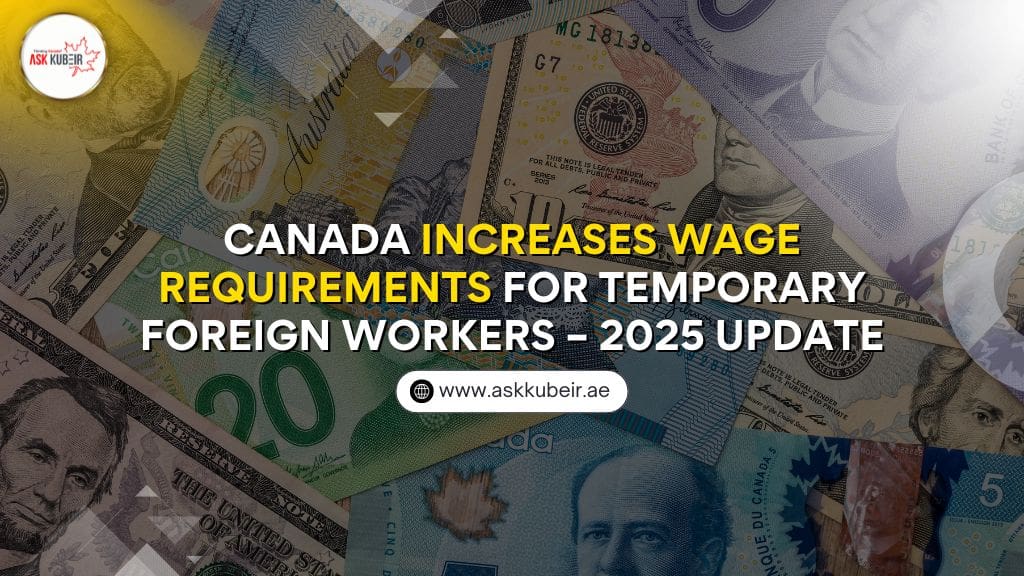
🔷 Canada has officially updated the minimum wages employers must pay to hire temporary foreign workers. These new wage thresholds are now in effect for all LMIA (Labour Market Impact Assessment) applications submitted on or after June 27, 2025.
This change is part of Canada’s effort to keep up with the rising cost of living and to make sure foreign workers are treated fairly. It also helps ensure Canadian and foreign workers receive competitive and region-based salaries.
🔷 What Has Changed in 2025?
If a Canadian employer wants to hire someone from outside Canada under the Temporary Foreign Worker Program (TFWP), they now have to pay higher wages depending on where the job is located. The wage level will also decide whether the job falls under the High-Wage Stream or the Low-Wage Stream.
- High-Wage Stream: If the job pays equal to or more than the set wage limit, the employer must follow more rules, like submitting a transition plan to reduce dependence on foreign workers.
- Low-Wage Stream: If the job pays less than the set wage limit, the employer has to meet extra requirements, including limits on hiring and providing housing, transportation, and healthcare for the worker.
🔷 Why Do These Changes Matter?
These updates use wage data from Statistics Canada’s Labour Force Survey (2023–2024), with a 20% adjustment based on the NOC 2021 system. That means wages now better match the real cost of living across each province or territory.
This wage update doesn’t just affect temporary work permits. It also affects:
- Canada Work Permit applications
- Provincial Nominee Program (PNP) eligibility
- Job offer validation for people applying for Canadian Permanent Residency (PR)
So if you’re an employer planning to hire from abroad or a worker aiming to move to Canada, these new wage rules directly impact you.
🔷 New Wage Thresholds by Province or Territory (Effective June 27, 2025)
Here’s how the wage changes look across Canada:
| Province/territory | For LMIAs received before June 27, 2025 | For LMIAs received as of June 27, 2025 |
|---|---|---|
| Alberta | $35.40 | $36.00 |
| British Columbia | $34.62 | $36.60 |
| Manitoba | $30.00 | $30.16 |
| New Brunswick | $28.85 | $30.00 |
| Newfoundland and Labrador | $31.20 | $32.40 |
| Northwest Territories | $47.09 | $48.00 |
| Nova Scotia | $28.80 | $30.00 |
| Nunavut | $42.00 | $42.00 |
| Ontario | $34.07 | $36.00 |
| Prince Edward Island | $28.80 | $30.00 |
| Quebec | $32.96 | $34.62 |
| Saskatchewan | $32.40 | $33.60 |
| Yukon | $43.20 | $44.40 |
🔷 How This Affects Work Permits and PR Applications
If you’re applying for a Canada Work Permit, or planning to immigrate through a Provincial Nominee Program (PNP), your job offer must now match these new wage rates. For those applying under Express Entry, this is especially important because a valid job offer with a competitive wage can increase your chances of getting selected for permanent residence.
For employers, this is a signal to revisit your recruitment strategy. Offering competitive wages that meet the updated standard is no longer optional—it’s necessary to stay compliant and avoid LMIA rejections or delays.
🔷 What Employers Should Know
If you are hiring under the High-Wage Stream, you must:
- Provide a transition plan to show how you will reduce long-term dependence on foreign workers
- Ensure wages meet or exceed the required minimum
- Follow all employment laws and worker protections
If you fall under the Low-Wage Stream, you will face more conditions:
- You can hire only a limited number of foreign workers
- You must arrange transportation, housing, and medical coverage
- Be prepared for closer government monitoring
🔷 Why This Change Matters for Canada’s Future
Canada is working to create a balanced job market that benefits both foreign and local workers. These new wage rules are designed to promote fairness, prevent wage suppression, and maintain strong employment standards across the country.
Whether you’re planning to move from India or any other country, it’s now more important than ever to understand the wage expectations tied to your job offer. If you’re unsure how this affects you, speaking to a licensed immigration consultant like Ask Kubeir can help you plan your next step with confidence.
Frequently Asked Questions (FAQs)
1. I have a job offer in Canada—do these changes affect me?
Yes. If you’re applying after June 27, 2025, your job offer must meet the new wage threshold for your province to be valid for a work permit or PR application.
2. Can I still apply for PR if my salary is below the threshold?
Your chances may be lower. For many PR programs, including Express Entry and PNP, your salary must match the regional standards. Otherwise, your job offer may not be accepted.
3. I’m an employer—what happens if I offer less than the new wage?
You’ll be categorized under the Low-Wage Stream, which comes with more rules, limits on how many foreign workers you can hire, and requirements like housing and transportation for employees.
4. Do these wage rules apply to everyone in Canada?
No, they apply to employers hiring foreign workers under the Temporary Foreign Worker Program (TFWP) and impact related immigration applications, such as work permits and PR streams involving job offers.
5. Where can I get help with LMIA or PR applications?
Reach out to trusted immigration experts like Ask Kubeir. We specialize in helping individuals and employers understand and succeed in the Canadian immigration process.

📞 Call us: 04 260 7837
📲 WhatsApp: wa.me/971529693030
🌐 Website: www.askkubeir.ae
📍 Office No. 45, 9th Floor, Conrad Tower, WTC, Dubai





